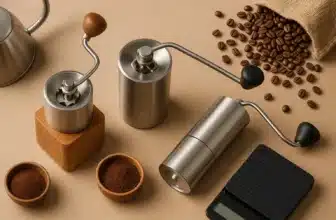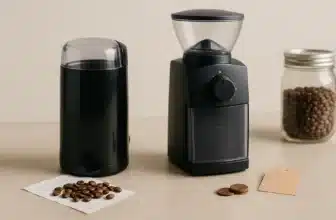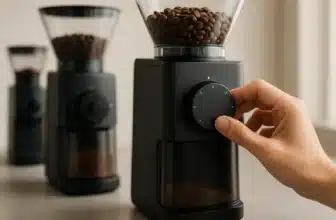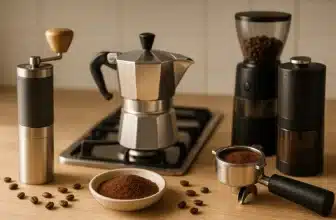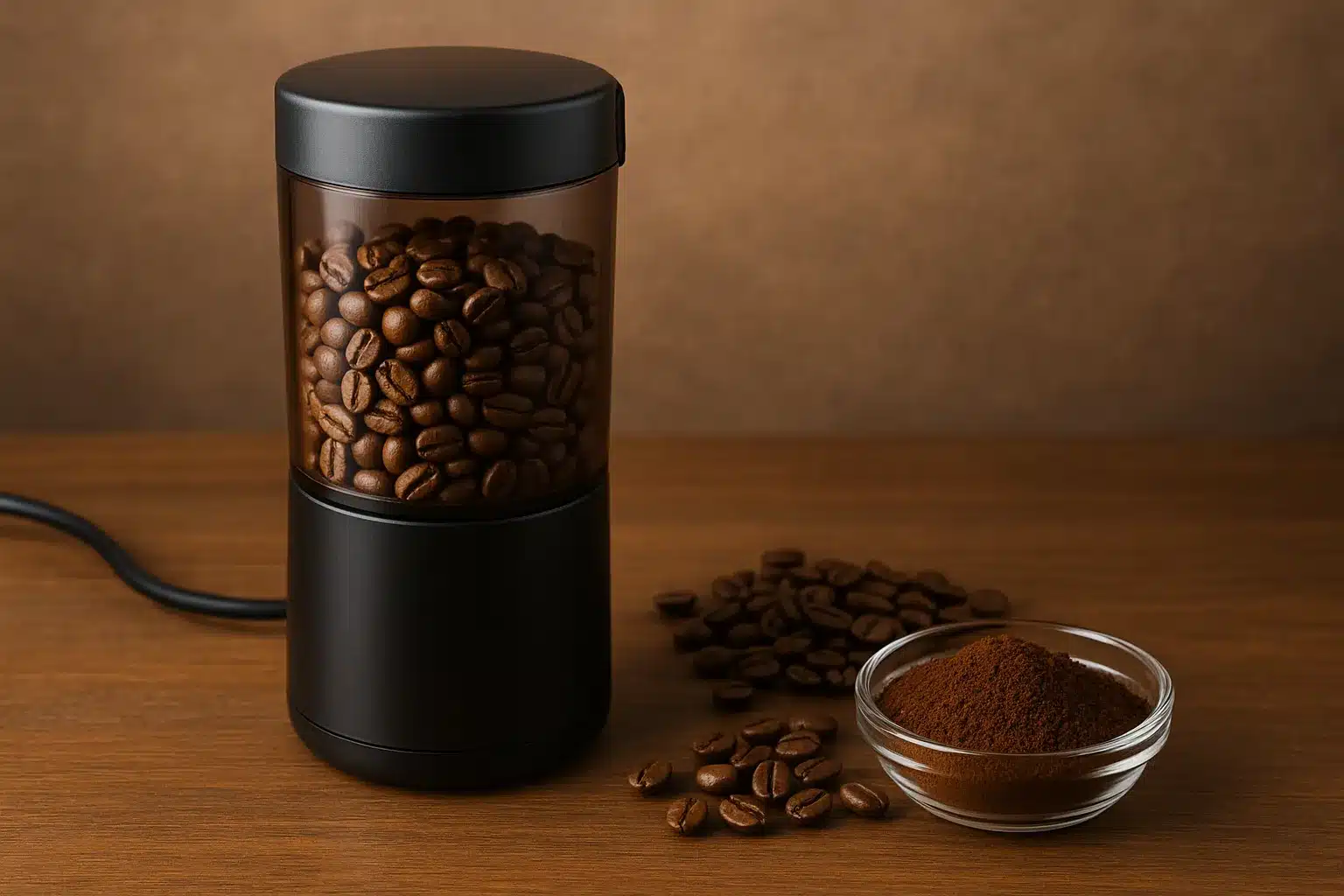
OneHundredCoffee is reader-supported, and some products displayed may earn us an affiliate commission. Details
If you love blended coffee beans—think chocolatey Arabica with a zing of Robusta, or a roaster’s house blend engineered for balance—you already know a grinder can make or break the cup. Blends are designed to sing together. But if your grind is uneven, you’ll pull bitter notes from one component and sour notes from another, and the harmony disappears. That’s why choosing a grinder isn’t just about price or looks; it’s about matching your brew style, your routine, and the unique personality of blended beans.
In this guide, we’re reviewing five popular grinders that home brewers frequently consider for blends:
- BLACK+DECKER One Touch Coffee Grinder
- Normcore Manual Coffee Grinder V1.1
- Gaggia MDF 55 Espresso & Coffee Grinder
- Nuttii Burr Coffee Grinder – Electric
- SHARDOR Coffee Grinder Electric

Best Coffee Grinders for Blended Coffee Beans at A Glance
| Image | Product | Features | Price |
|---|---|---|---|
Best Simple Blade Grinder  | Price on Amazon | ||
Best Portable Hand Grinder  |
| Price on Amazon | |
Best Entry-Level Espresso Grinder 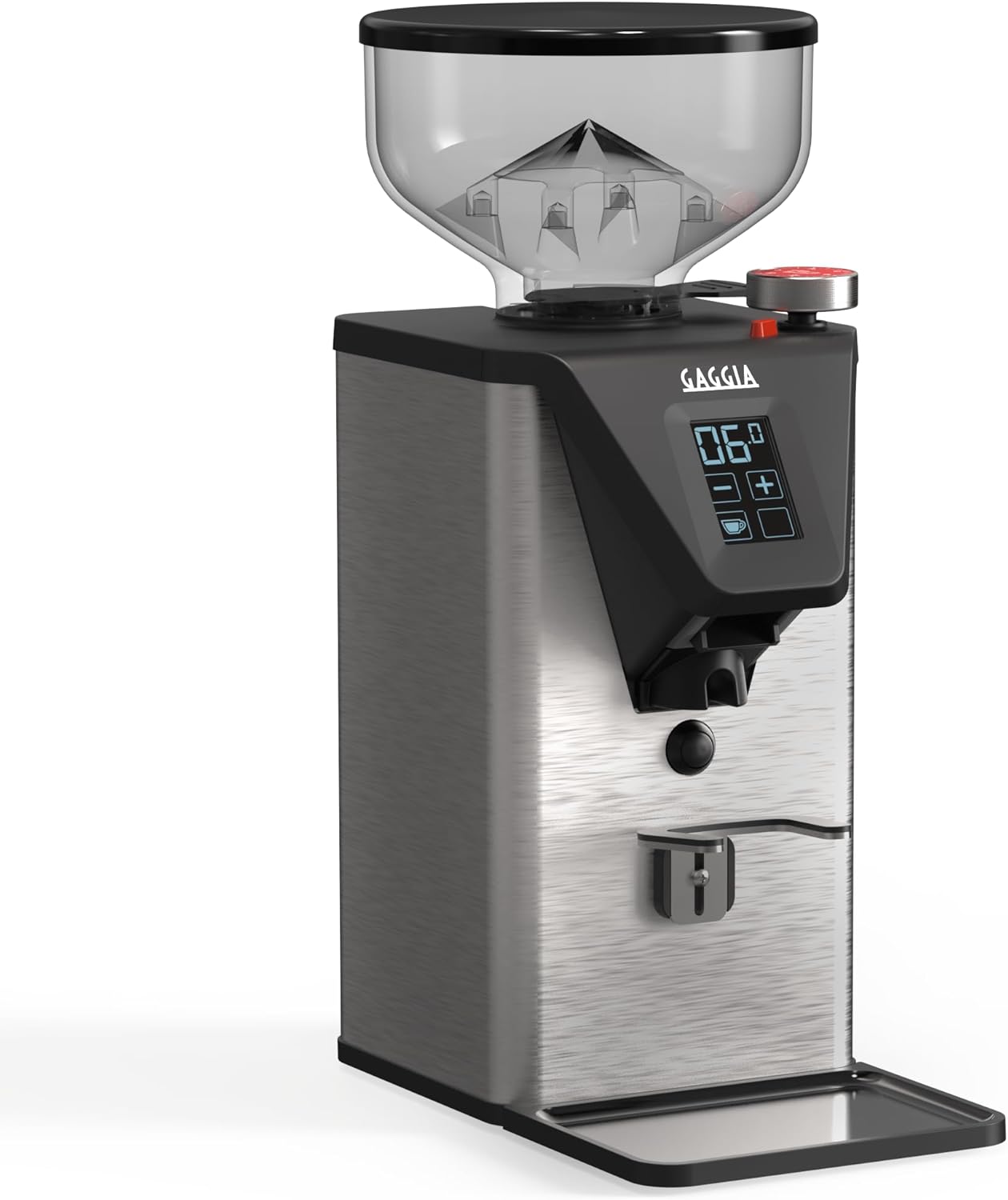 |
| Price on Amazon | |
Best Adjustable Electric Grinder 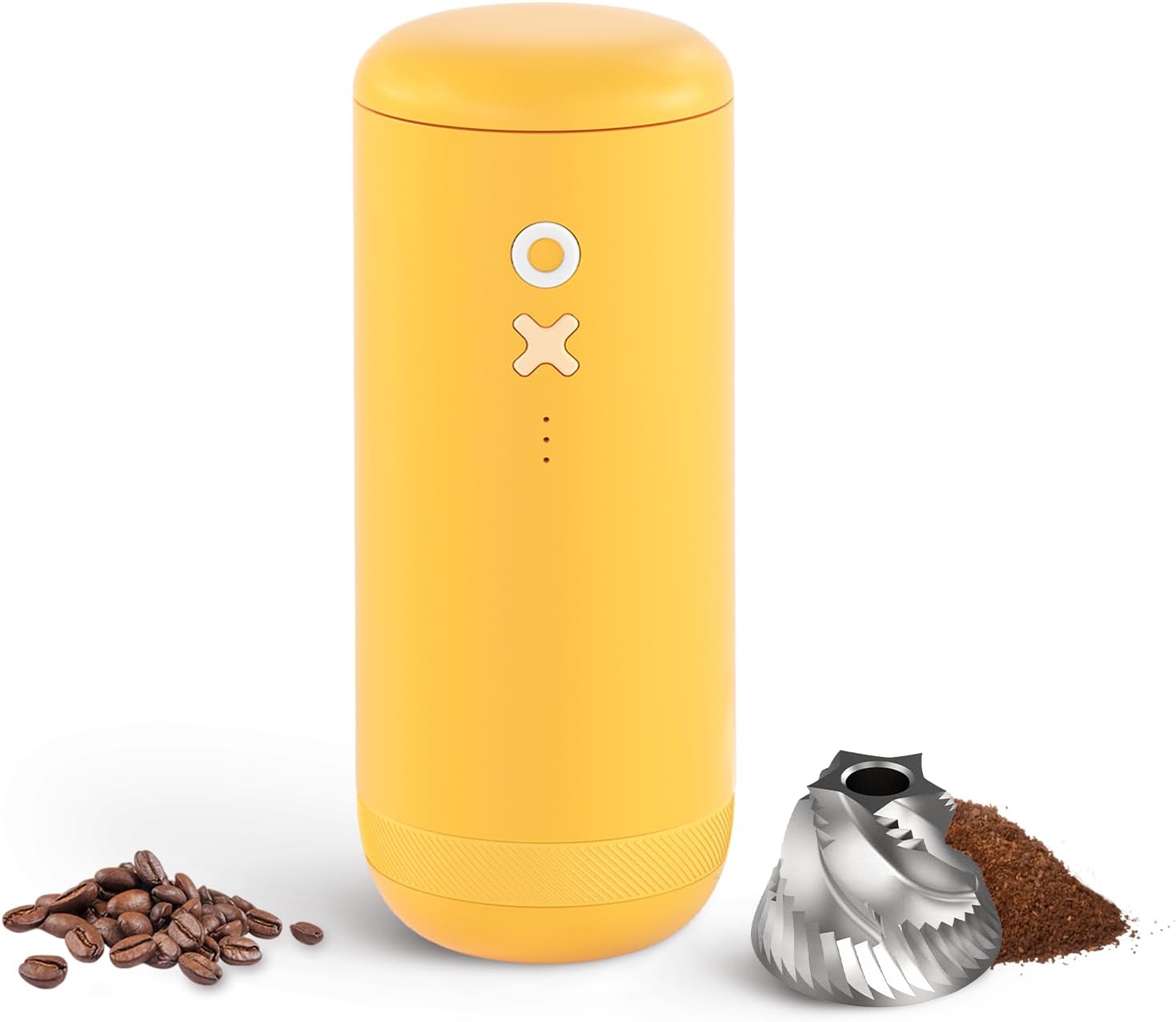 |
| Price on Amazon | |
Best Precision Timer Grinder  | SHARDOR Electric Burr Coffee Grinder — 40-Second Adjustable Precision Timer |
| Price on Amazon |
We’ll unpack how they feel in daily use, where they shine, and what to watch out for—especially when you’re switching blends, moving between brew methods, or working with darker/oilier components that love to cling to chutes and lids. You’ll also find a quick comparison table, a buyer’s guide focused specifically on blended coffee beans, and a straight-talk conclusion with personal picks.
Quick Comparison Table
| Model | Type | Burr/Blade | Grind Range | Best For | Portability | Noise | Cleaning Ease | Price Band | Our Take |
|---|---|---|---|---|---|---|---|---|---|
| BLACK+DECKER One Touch | Electric | Blade | Coarse–Medium (manual pulsing) | Cold brew, French press on a budget | High | Moderate | Easy (simple chamber) | $ | Budget simplicity; pulse & shake for better results |
| Normcore V1.1 | Manual | Conical burr | Espresso–Pour-over | Travelers, precision lovers | Very high | Very quiet | Easy (no electronics) | $$ | Compact precision with minimal static |
| Gaggia MDF 55 | Electric | Flat/Conical burr (espresso-first design) | Espresso–Medium | Serious home espresso & milk drinks | Low | Moderate | Moderate (burr path, hopper) | $$$ | Espresso dial-in champ; consistent for milk drinks |
| Nuttii Burr Electric | Electric | Conical burr | Drip–Pour-over–Medium | Daily drip lovers, first burr | Medium | Moderate | Easy–Moderate | $$ | User-friendly settings for everyday blends |
| SHARDOR Coffee Grinder Electric | Electric | Conical burr* | Drip–Pour-over–Medium | Value hunters; multi-cup mornings | Medium | Moderate | Easy | $$ | Good value—ensure you choose the burr version |
*Some SHARDOR models are blade grinders. For blended beans and consistency, choose the burr variant.
How We Think About Grinding Blends
Blends can mix beans of different densities and roast levels. That affects how the beans fracture. In practice:
- Consistency matters more with blends, so each component extracts in harmony.
- Heat control (short bursts, slower cranks, or cooler burrs) helps protect aroma oils.
- Static and retention can hide grounds from a darker component, skewing flavor balance.
- Adjustment granularity is valuable if you brew espresso one day and pour-over the next.
With that in mind, let’s get into the detailed reviews.
BLACK+DECKER One Touch Coffee Grinder

BLACK+DECKER One Touch Coffee Grinder (CBG110S)
Key Features
- Stainless steel blades for fast, uniform grinding
- One-touch push-button operation
- Compact design with cord storage
- Transparent lid for grind monitoring
- Holds enough beans for up to 12 cups
Why We Like It
A straightforward, reliable grinder for everyday coffee drinkers. Push once, grind to preference, and brew fresh without fuss.
Pros
- Easy one-button use
- Compact and lightweight
- Affordable entry-level grinder
- Simple cleanup and storage
Cons
- Blade grinder, less precise than burrs
- Short grind cycles recommended to avoid overheating
Bottom Line
A simple, budget-friendly grinder perfect for beginners and drip coffee enthusiasts who want no-hassle daily grinding.
Price on AmazonBest for budget simplicity, spices, and coarse-leaning brews
Here’s our detailed review. If you want something that just works, lives in a drawer, and doesn’t require a manual, the BLACK+DECKER One Touch is the friendly neighbor of grinders. It’s a classic blade grinder: pop in the beans, press, and the blade whirls. For blended coffee beans, a blade grinder can absolutely produce drinkable coffee—especially for cold brew and French press—but it needs care and technique.
Daily use & feel. The One Touch is lightweight, compact, and genuinely simple. The transparent lid lets you peek at progress, and the single-button operation is as straightforward as it gets. There’s plenty of room for a few cups’ worth of coffee; the chamber is easy to access for measuring and cleaning.
Grind quality for blends. The challenge with blade grinders is uniformity. You’ll get a mix of fines and boulders unless you apply the well-known hacks: short pulses, shaking the grinder between pulses, and stopping early. For blends, that strategy helps avoid overheated fines from one component and under-extracted chunks from another. If your blend includes a darker, oilier bean, the aroma can be muddied if you over-grind in a single long hold; pulsing helps keep things cooler and more even.
Brew pairing. For coarse methods—French press and cold brew—the One Touch can be a perfectly pleasant companion. The cup won’t be competition-level, but it can be flavorful and satisfying, especially with roaster blends designed for immersion brews. For pour-over or espresso, the lack of precision makes consistency tricky. You can still experiment, but you’ll need patience and lots of pulsing.
Noise & cleanup. Noise is typical for a small electric grinder—noticeable but short-lived. Cleanup is easy: wipe the chamber with a dry brush or towel, and occasionally rinse the lid carefully. Oily blends may leave a sheen on the chamber; a quick wipe with a slightly damp cloth (followed by a dry cloth) keeps aromas fresh.
Who will love i?. If you’re blend-curious on a tight budget, brew coarse most of the time, and prefer the smallest learning curve, this is a friendly starter. It’s also a great spice grinder when you upgrade later.
Where it struggles. Precision. If you love dialing in a house espresso blend and want repeatable shots, you’ll want burrs.
Bottom line. For affordable coffee and coarse-leaning blends, the One Touch delivers convenience with a few technique tweaks. Pulse, shake, stop early—and enjoy.
Normcore Manual Coffee Grinder V1.1

Manual Coffee Grinder — Adjustable Stainless Steel
Key Features
- Durable stainless steel body for long-lasting use
- Adjustable grind selector (fine to coarse)
- Compact, lightweight, and travel-friendly
- Quiet hand-crank operation, no electricity needed
- Easy to clean and maintain
Why We Like It
A sturdy stainless-steel manual grinder that offers surprising grind consistency, portability, and silent operation—perfect for travel, camping, or quiet mornings at home.
Pros
- Solid stainless steel construction
- Adjustable grind for espresso to French press
- Portable and lightweight design
- Quiet, power-free operation
Cons
- Manual grinding requires effort
- Limited capacity for large batches
Bottom Line
A travel-ready, budget-friendly grinder that delivers consistent results and durability—ideal for single cups and portable brewing setups.
Price on AmazonBest for portable precision and blend-friendly consistency
Here’s our detailed review. The Normcore V1.1 is a sleek manual conical burr grinder that feels purpose-built for people who enjoy the ritual. It weighs little, packs beautifully, and produces remarkably consistent grounds for pour-over and even light espresso work. For blended beans, that consistency is a gift: different components fracture more predictably under sharp conical burrs, so your blend’s intended profile shows up more clearly in the cup.
Build & ergonomics. The V1.1 typically features an all-metal body, a comfortable handle, and a clean, click-based adjustment system (varies by sub-version). The tolerances feel tight; you don’t get wobbles or grinds rubbing where they shouldn’t. The catch cup threads securely, and the whole unit feels more “instrument” than “gadget.”
Grind quality for blends. Conical burrs deliver well-shaped particles with fewer wild outliers than a blade grinder, and at this size, the Normcore’s consistency is genuinely impressive. Medium to medium-fine shines for pour-over and Aeropress. If your blend pairs a nutty medium roast with a chocolatey darker roast, the Normcore brings out the chocolate sweetness without smearing everything into roastiness. With careful adjustment and fresh beans, you can push toward espresso territory, though you’ll be working your forearm for several shots in a row.
Static, retention & switching blends. One advantage of a compact manual grinder is low retention. When you switch blends—say, from an espresso blend to a filter blend—very little old coffee lingers in the path. That’s especially helpful when one component is oily; the burrs stay cleaner, flavors stay truer, and static is usually modest in dry climates.
Noise & speed. It’s whisper-quiet. Grinding a single cup’s worth takes under a minute for most people at filter settings; finer settings take longer. If you’re grinding for a crowd, this is not its comfort zone.
Who will love it? Home brewers who value portability, quiet mornings, and the ability to precisely dial in a house blend for pour-over. It’s also ideal for travel—toss it in a bag with a small kettle and you’re set.
Where it struggles. Batch brewing and back-to-back espresso shots. It can do them—but it’s a workout.
Bottom line. The Normcore V1.1 is a sweet-spot manual grinder for blended beans: clean flavor, reliable consistency, minimal retention, and a tactile, satisfying grind. If you prize clarity and control, it’s a charmer.
Gaggia MDF 55 Espresso & Coffee Grinder

Gaggia MDF Espresso & Coffee Grinder
Key Features
- 50 mm flat burrs for consistent espresso grinding
- 34 grind settings from espresso fine to drip coarse
- Sturdy ABS housing with compact footprint
- Doser chamber for quick espresso dosing
- Designed for home baristas stepping into espresso
Why We Like It
A tried-and-true grinder that pairs reliably with entry and mid-level espresso machines. The stepped adjustment makes dialing in simple while flat burrs provide solid consistency for shots.
Pros
- Good espresso grind quality for beginners
- Durable build with Italian design
- Simple stepped adjustments
- Compact and affordable compared to prosumer grinders
Cons
- Less micro-adjustable than stepless grinders
- Doser design less convenient for single dosing
Bottom Line
A dependable entry-level flat burr grinder—ideal for beginners who want reliable espresso grinds without overspending.
Price on AmazonBest for espresso lovers who want café-style consistency at home
Here’s our detailed review. The Gaggia MDF 55 (and similar MDF family grinders) leans espresso-first in attitude: sturdy construction, burrs designed for fine control, and adjustment that lets you chase the sweet spot in an espresso blend. If your blend aims to cut through milk with cocoa and toasted sugar notes, this grinder helps you repeat that delicious shot tomorrow—and the day after.
Build & usability. Expect a heftier, counter-ready machine with a proper hopper, a stable footprint, and a chute or dosing system suited for portafilters. The controls and adjustments are designed for steady, incremental tweaks. Compared to compact manuals or entry-level electrics, you feel the step up in solidity and workflow.
Grind quality for blends. Espresso blends are where the MDF 55 shines: it produces fine, even grounds that extract predictably. If your blend mixes a slightly darker base with a medium component for aromatics, you’ll notice it’s easier to keep bitterness at bay without losing texture. Milk drinks benefit too—consistent particle size means consistent crema and dependable sweetness in cappuccinos and lattes.
Dial-in experience. Espresso blends often ask for micro-tuning day to day (humidity, age of beans, and even how you tamp). The MDF 55’s adjustment accommodates that dance. Small nudges actually feel small. Once you’ve got a blend dialed, you can return to it with confidence.
Static, retention & cleanup. As a larger electric burr grinder, there’s typically more path length for grinds than a tiny manual, so a bit more retention is normal. Regular sweeps with a brush and occasional deeper cleaning keep the flavor path clear. Oily blends may require more frequent upkeep—par for the course with espresso-first grinders.
Brew versatility. While it’s designed for espresso, it can step up to medium for Moka pots and some pour-over styles. But you buy this for espresso. If your routine is 90% filter, choose a different hero.
Who will love it? Home baristas who want reliable, café-leaning espresso, especially with house blends formulated for milk drinks and balanced shots.
Where it struggles. Price and footprint versus entry options. And it’s overkill if you rarely make espresso.
Bottom line. For espresso blend fanatics, the Gaggia MDF 55 is a dial-in companion that lets a roaster’s intent shine. Predictable shots, lush mouthfeel, and a workflow that feels serious—in a good way.
Nuttii Burr Coffee Grinder – Electric

Nuttii Burr Coffee Grinder — Electric Adjustable
Key Features
- Precision stainless steel conical burrs for even grinding
- Multiple grind settings from fine espresso to coarse French press
- Large-capacity hopper for extended brewing sessions
- Low-noise motor design for quieter operation
- Anti-static grounds bin to minimize mess
Why We Like It
This Nuttii grinder hits a sweet spot of adjustability, capacity, and quiet performance—perfect for coffee lovers who want fresh grounds for any brew method without breaking the bank.
Pros
- Wide range of grind sizes
- Consistent burr performance
- Quiet and user-friendly
- Generous hopper and grounds bin
Cons
- Not suitable for ultra-fine Turkish coffee grind
- Plastic exterior feels less premium
Bottom Line
A versatile and reliable electric burr grinder that covers daily brewing needs with ease and consistency.
Price on AmazonBest for everyday drip with an approachable burr upgrade
Here’s our detailed review. The Nutti Burr Coffee Grinder (Electric) is the “first real burr” kind of upgrade many home brewers want: compact, straightforward controls, and dependable medium-range performance that makes blended beans taste cleaner and sweeter than a blade grinder can manage. If your house blend is brewed daily as drip or pour-over, it checks the right boxes.
Design & usability. Expect a counter-friendly shape, a hopper sized for daily use, and a collection bin or grounds cup that sits firmly in place. The interface is usually intuitive: a grind setting ring or dial and a simple on/off or timer. It’s the definition of approachable.
Grind quality for blends. Moving from blade to conical burrs is where you taste the upgrade most clearly. Bitterness drops off, clarity improves, and you can actually dial a blend to highlight what you enjoy—nutty sweetness, cocoa body, or a balanced citrus sparkle. The Nuttii’s comfort zone is drip to medium-fine; it can go coarser for immersion and finer for strong pour-over without much drama.
Consistency & switching blends. For a value-oriented electric burr, consistency is solid enough for day-to-day brewing. Retention is modest; a quick tap and brush clears the path if you change blends mid-week. If your blends include darker components, wipe any oil sheen from the chute occasionally to keep flavors fresh.
Noise & speed. Similar to most compact electrics—there’s noise, but it’s short. It grinds a weekday pot of coffee in a minute or two and doesn’t slow you down.
Who will love it? Anyone who wants to graduate from a blade grinder to a real burr without getting lost in espresso-level complexity. It’s a great match for roasters’ filter blends.
Where it struggles. Hardcore espresso dial-ins. It can manage a Moka pot or strong Aeropress, but it’s not built to chase 0.5-click changes for ristretto.
Bottom line. A friendly, practical burr grinder that makes blends taste like they were meant to taste—balanced, sweet, and repeatable.
SHARDOR Coffee Grinder Electric

SHARDOR Electric Burr Coffee Grinder — 40-Second Adjustable Precision Timer
Key Features
- 40-second precision timer for consistent dosing
- Adjustable grind settings from espresso to French press
- Conical burr system preserves aroma and flavor
- Large capacity grounds bin for multiple cups
- Sturdy build with intuitive controls
Why We Like It
The SHARDOR’s timed grinding function makes it simple to repeat recipes without scales. It’s compact yet capable, offering versatility across brew methods at an approachable price.
Pros
- Precise timer avoids guesswork
- Wide grind range for espresso to coarse brews
- Consistent burr grinding preserves flavor
- Good capacity for family or office use
Cons
- Plastic build less durable than premium grinders
- Some retention between doses
Bottom Line
A practical grinder with a built-in timer—great for everyday coffee drinkers who want convenience without sacrificing consistency.
Price on AmazonBest value pick—just be sure to choose the burr version
Here’s our detailed review. SHARDOR sells both blade and burr grinders. For blended beans, the burr version is the one you want: better consistency, better heat control, and truly better cups when you brew the same blend day after day. This value-minded electric burr grinder aims to deliver easy wins for busy mornings.
Setup & controls. Expect a straightforward layout: hopper, grind adjustment, grounds cup, and either a button or timer. It’s not fussy. The footprint works well on small counters, and the hopper is ample for family brewing.
Grind quality for blends. With conical burrs, SHARDOR’s burr grinder produces a notably more even grind than a blade model. That consistency lets a roaster’s blend design shine—sweet base notes, clear mid-tones, and balanced finish. If your blend straddles medium and medium-dark beans, you’ll appreciate how the burrs limit fines that can make darker components taste ashy.
Versatility. It’s comfortable across medium-coarse to medium-fine. Drip, pour-over, Chemex, and immersion are its strongest lanes. It can brave a more concentrated brew style with patience, but precision espresso chasing isn’t its core mission.
Maintenance & static. With value-oriented electrics, expect a little static in dry climates; a quick spritz with the Ross Droplet Technique (RDT)—a very light water mist on beans—can cut cling dramatically. A soft brush keeps the chute tidy, and a simple wipe prevents oil build-up when you enjoy darker blend components.
Who will love it? Value hunters who brew filter coffee for a couple of people and want a step-change upgrade from a blade grinder without stepping into enthusiast pricing.
Where it struggles. Ultra-fine tuning for espresso and highly demanding single-dose workflows.
Bottom line. For everyday blended beans brewed as a filter, SHARDOR’s burr grinder is a practical, affordable pick that makes better coffee with minimal effort. Just double-check you’re not grabbing the blade version.
Buyer’s Guide: Choosing a Grinder for Blended Coffee Beans
1) Burr vs. Blade
- Burr grinders (conical or flat) crush beans to a more uniform size—key for blends. They produce cleaner cups, more predictable extraction, and better flavor separation.
- Blade grinders chop beans and create more fines/boulders. With blends, that can skew the balance. If you must use a blade grinder, pulse and shake for coarser methods.
2) Manual vs. Electric
- Manual burrs (like the Normcore) are quiet, portable, and low-retention—great for switching blends often and traveling. They do require effort for batches.
- Electric burrs (like Nuttii, SHARDOR, Gaggia MDF 55) are faster and easier for families. Espresso-forward models shine if you love milk drinks and daily shots.
3) Grind Range & Adjustment
- Espresso needs fine, granular control (small steps or stepless).
- Filter and immersion benefit from stable medium-range performance.
- If you brew multiple methods with one blend, choose a grinder that adjusts predictably between them.
4) Heat, Static & Retention
- Heat can dull aromatics in blends. Shorter grind times and pulse techniques help.
- Static makes grounds cling; RDT (one tiny mist) dramatically reduces mess.
- Retention (grounds left behind) can carry yesterday’s darker component into today’s lighter blend. Single-dose workflows or low-retention designs help.
5) Oily/Darker Blend Components
- Wipe chutes and chambers periodically. A light brush after every session keeps flavors true and prevents stale residues.
6) Capacity & Workflow
- Brewing for one? A manual or small electric is perfect.
- Brewing for a family? Choose an electric burr with a comfortable hopper and cup.
- Espresso daily? Pick an espresso-capable grinder with fine control.
7) Noise & Space
- Manuals are quiet and compact.
- Electrics make noise—but fast. Check counter height and cabinet clearance.
8) Budget Bands (rough guide)
- $: Blade simplicity (BLACK+DECKER) for coarse-leaning brews.
- $$: Entry burrs (Nuttii, SHARDOR burr) and quality manuals (Normcore) for excellent filter coffee.
- $$$: Espresso-forward electrics (Gaggia MDF 55) for café-style dial-ins.
Which Grinder Should You Buy? (Friendly Scenarios)
- “I brew cold brew or French press and want the easiest start.”
Go BLACK+DECKER One Touch and master the pulse-and-shake routine. Affordable, compact, and perfectly fine for coarse blends. - “I travel, love pour-over, and want clean, sweet cups from blends.”
Choose Normcore V1.1. It’s quiet, precise, and reveals nuance. - “I’m an espresso person and want milk drinks with a house blend.”
Gaggia MDF 55 is your home barista upgrade—dial-in heaven. - “We brew drip daily and want a real burr without complexity.”
Nuttii Burr Electric is a happy medium: consistent, approachable, and tidy. - “I want the best value burr for filter coffee.”
SHARDOR Coffee Grinder Electric (burr version)—double-check the product page and enjoy the upgrade.
FAQs for Blended Beans & Grinders
Do blends require a different grind than single origins?
Not inherently, but blends often include beans with different densities and roast levels. A more consistent grinder helps extract them together harmoniously. Start at your usual grind setting and adjust taste-by-taste.
Why does my darker blend taste ashy or bitter?
Likely over-extraction of finer particles or heat buildup during grinding. Coarsen slightly, use shorter grind bursts, or switch to burrs for more uniformity.
Can I use one grinder for espresso and pour-over with blends?
Yes, but you’ll want predictable adjustment and minimal retention. Manual single-dose (Normcore) or an espresso-capable electric (Gaggia MDF 55) works; just note the trade-offs in speed and convenience.
How often should I clean my grinder with blends?
Wipe weekly if you brew daily. Brush chutes and cups lightly every session. Darker/oilier components may benefit from more frequent wipes.
Personal Opinion & Final Conclusion
If I had to crown winners for blended coffee beans:
- Best Overall for Filter Blends: Nuttii Burr Coffee Grinder – Electric. It hits that sweet spot of approachable burr performance, friendly price, and everyday consistency. Your house blend will taste sweeter and more balanced, without fuss.
- Best Manual & Travel Choice: Normcore Manual Coffee Grinder V1.1. It’s compact, beautifully built, and delivers clarity that brings a roaster’s blend design to life. If you enjoy the ritual (and the quiet), this is a joy.
- Best Espresso Pick: Gaggia MDF 55 Espresso & Coffee Grinder. For people who live for milk drinks or straight shots from a classic espresso blend, it provides the fine control and stability to make repeatable, delicious espresso at home.
- Best Budget Starter (Coarse-Leaning): BLACK+DECKER One Touch. With a bit of technique, it’s a practical way to enjoy blended beans in a French press and cold brew while you save for burrs later.
- Best Value Burr Reminder: SHARDOR Coffee Grinder Electric (burr version). It’s a solid daily driver for filter coffee—just ensure you pick the burr model, not the blade.
Final sip. Blends are crafted to taste better together. The grinder’s job is to keep that harmony intact. Whether you’re stepping into burrs for the first time or dialing in an espresso blend, the right grinder turns your morning cup from “good” to consistently great—and once you taste a blend brewed at its best, there’s no going back.
Customer Guide: Quick Setup Tips for Blended Beans
- Dose & Grind
- Start with your usual recipe (e.g., 1:15 for pour-over, 1:16–1:18 for immersion) and grind medium. If a darker component tastes bitter, coarsen a notch; if it tastes flat, go a hair finer.
- Pulse Technique (Blade Grinders)
- Short bursts (1–2 seconds) + shake between pulses. Stop once the bulk looks right; don’t chase perfection—it produces heat and fines.
- RDT for Static (Burr Grinders)
- Lightly mist beans once (don’t wet them) to reduce static and retain fewer grounds in the chute.
- Switching Blends
- Purge a gram or two, or brush the chute. For manuals, simply grind the new beans; retention is minimal.
- Taste & Adjust
- Blends are forgiving but responsive. One click finer/coarser changes sweetness, body, and clarity. Keep notes; your perfect cup is repeatable.
Mini Comparison Snapshot (By Role)
- Coarse Brew Champion: BLACK+DECKER One Touch (with pulse-and-shake)
- Quiet Precision: Normcore V1.1
- Espresso Consistency: Gaggia MDF 55
- Everyday Drip Hero: Nuttii Burr Electric
- Value Burr for Families: SHARDOR (burr version)



